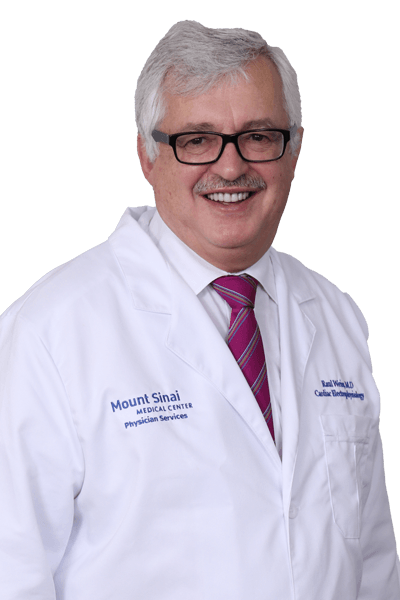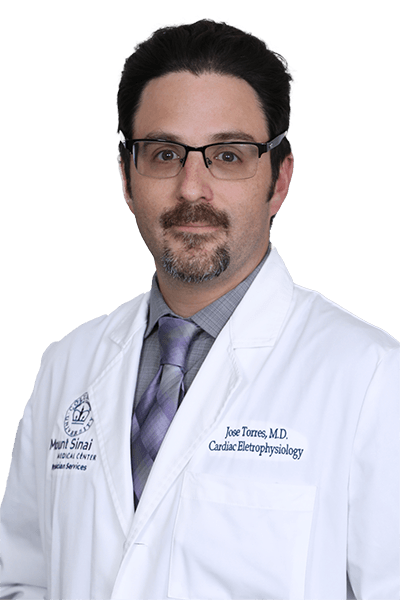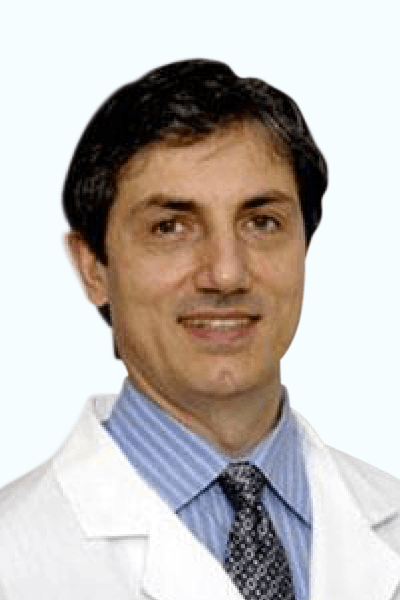Electrophysiology
Normally, the heart beats at a steady rhythm to supply blood to the lungs and the rest of the body. For some people, though, the heart beats irregularly. We call this irregular heartbeat an arrhythmia. Their hearts can beat too slowly (bradycardia), too quickly (tachycardia), or too early (premature). When the heart doesn’t beat as it should, normal circulation of the blood can suffer; and when your circulation is irregular, it can cause a wide range of problems, from dizziness and fatigue to stroke and even sudden death.
Cardiac electrophysiology is a branch of cardiology that deals exclusively with the detection and treatment of heart rhythm disorders (arrhythmias), which affect millions of Americans. Electrophysiologists treat arrhythmias using the body’s natural electrical current, using medications, and using artificial sources of electrical current, as well as surgical and non-surgical procedures.
Experts Working Together
At the Mount Sinai Heart Institute, patients with common and rare heart rhythm disorders receive advanced diagnostics and innovative treatments from a team of highly skilled electrophysiologists. In addition, our electrophysiologists work in collaboration with other top-ranked cardiac experts at Mount Sinai, including our clinical and interventional cardiologists, as well as our cardiac surgeons.
At Mount Sinai, our electrophysiologists provide highly specialized care for disorders such as atrial fibrillation, the most common type of arrhythmia; supraventricular tachycardia; and ventricular tachycardia. We use a state-of-the-art electrophysiology lab equipped with computer mapping systems that allow our specialists to diagnose and treat a wide range of the most complex arrhythmias and to evaluate fainting (syncope) disorders. In addition, our team of experts utilizes devices, such as pacemakers and defibrillators, to treat arrhythmias.
Symptoms
An arrhythmia may be present all of the time or it may come and go. Some people do not experience any symptoms, while others notice symptoms only when they are more active. Common signs include:
- Chest pain
- Disturbed sleep
- Dizziness or lightheadedness
- Confusion
- Fainting
- Fast pulse
- Fatigue
- Heart palpitations (sensation that your heart is pounding or racing)
- Irregular heartbeats (fast or slow)
- Pallor (a pale appearance)
- Premature contractions (extra, early, or “skipped” heartbeats)
- Shortness of breath
- Stroke
- Sweating
What Causes Irregular Heartbeats
Arrhythmias can be caused by problems with the heart’s natural electrical system; structural problems in the heart or blood vessels caused by birth defects; heart disease; or induced by medications or exposure to certain certain chemicals and drugs.
Atrial Fibrillation
Atrial fibrillation (A-Fib) is the most common chronic heart rhythm disorder in adults, affecting more than five million Americans and millions more worldwide. A-Fib is characterized by disorganized episodes of rapid, irregular beating of the heart’s upper chambers (atria). At Mount Sinai, we determine the severity of A-Fib based on the patient’s symptoms, how long each episode of irregular heartbeats lasts, how long the patient has experienced these episodes, the size of the patient’s left atrium (which can enlarge over time), and the presence of structural heart diseases, such as abnormalities in the valves, vessels, and other parts of the heart.
Symptoms of A-Fib typically include heart palpitations, fatigue, shortness of breath, chest discomfort, rapid heartbeat, dizziness, and, rarely, fainting. Many patients with A-Fib are at increased risk of stroke because blood can pool inside their heart, where it can thicken and cause clots. These clots can travel to the brain and cause a stroke. Because of this risk, people with A-Fib require ongoing care and, usually, medical management of their A-Fib.
A-Fib is commonly associated with an enlarged left atrium, a leaky mitral valve (mitral regurgitation), and fluid retention causing accumulation of water in the lungs with shortness of breath or congestive heart failure.
Treatment of A-Fib may include medication, cardioversion, or ablation. Some patients with A-Fib can have a slow heartbeat at times, which may be treated with a pacemaker. Mount Sinai also offers the innovative Hybrid Maze Procedure for patients with chronic A-Fib and enlarged left atria, which are generally difficult to treat with medication and single catheter ablation treatments. These procedures are minimally invasive and are very well tolerated procedures that can cure patients long-term of their atrial fibrillation. These procedures typically mean patients can stop medications and blood thinners long-term.
Atrial Flutter
Atrial flutter (AFL) shares many similarities with atrial fibrillation. However, AFL is caused by a single electrical wave that circulates very rapidly in the upper chambers of the heart (usually the right atrium) in an organized pattern. People with AFL usually continue to have a steady heartbeat, even though it is faster than normal. Patients with AFL may not have any symptoms, or they may experience symptoms similar to atrial fibrillation. Treatment for AFL typically includes medication, cardioversion, and catheter ablation.
Heart Block
Heart block is a condition characterized by an abnormally slow heartbeat (bradycardia). It occurs when some or all of the electrical impulses from the upper chambers of the heart are not properly transmitted to the lower chambers of the heart. Symptoms of heart block may include fainting, dizziness, lightheadedness, and shortness of breath. Treatment may include lifestyle changes to address other heart conditions, medication changes, and implanting pacemakers.
Long QT Syndrome
Long QT syndrome (LQTS) is an inherited electrical disorder that puts patients at risk for sudden cardiac death. At Mount Sinai, we diagnose LQTS by looking for abnormalities in a patient’s electrocardiogram and genetic testing. Long QT may also be acquired after taking certain medications, or it may be caused by a combination of heredity and medications.
Symptoms of LQTS include palpitations, rapid heartbeat, and fainting. Treatment includes limiting physical activity, taking medications to prevent chaotic heart rhythm, avoiding medications known to cause prolonged Q-T intervals, and implanting devices, such as internal defibrillators. Patients with LQTS may also be susceptible to Torsades de Pointes, a type of ventricular tachycardia.
Sick Sinus Syndrome
Sick sinus syndrome (SSS), or sinus node dysfunction, refers to the malfunction of the heart’s natural electrical regulator, the sinoatrial node. SSS often results in an abnormally slow heartbeat at rest (bradycardia), occasional heartbeat pauses, or a heartbeat that fails to speed up with activity or in response to adrenaline. Some patients with SSS will have a combination of slow and rapid heart rhythms. Many people have no symptoms, while others experience fatigue, fainting, shortness of breath, chest pain, disturbed sleep, confusion, and heart palpitations. Treatment for patients with severe SSS often requires your Mount Sinai cardiac experts to implant a permanent pacemaker.
Supraventricular Tachycardia
Supraventricular tachycardia (SVT) describes several types of fast heartbeats that are caused by electrical problems in the upper chambers (atria) of the heart but are not typically dangerous. Patients with SVT usually have a rapid and steady pulse that is accompanied by heart palpitations, fatigue, or shortness of breath. These episodes start suddenly and stop suddenly. Treatment options include medications or catheter ablation.
Ventricular Fibrillation
Ventricular fibrillation (VF) is a dangerous condition that can cause sudden cardiac death by causing rapid, disorganized beating of the heart’s main pumping chambers (ventricles). In these instances, the heart stops beating effectively; blood flow to the brain is cut off; the patient faints and then suddenly dies. VF can happen during a heart attack (myocardial infarction) or be caused by previous heart damage or a genetic heart condition. Life-saving shock (defibrillation) must be delivered to the heart within minutes of a VF episode to restore a normal heart rhythm and blood flow. In the interim, cardiopulmonary resuscitation (CPR) may keep blood flowing while emergency aid arrives.
Ventricular Tachycardia
Ventricular tachycardia (VT) is an electrical heart rhythm disorder, and its primary symptom is a very fast heart rate. VT has many features in common with ventricular fibrillation. It is usually seen in the setting of other serious heart diseases and can be life-threatening. If VT does not stop on its own, it usually requires treatment with medication, electrical cardioversion, catheter ablation, or implanting a defibrillator. VT requires aggressive monitoring and treatment, as it can lead to ventricular fibrillation and sudden death.
Diagnosing Heart Rhythm Disorders
To diagnose an arrhythmia, your Mount Sinai cardiologist or electrophysiologist will first listen to your heart with a stethoscope, check your pulse, and perform an electrocardiogram (EKG). He or she may then ask you to wear a heart-monitoring device, such as a Holter monitor or event recorder, to measure your heart rhythm over time. If abnormalities are present, the doctor may recommend procedures and tests that evaluate heart function. These may include:
Cardiac Catheterization and Coronary Angiography
Cardiac catheterization is required for a number of heart procedures and is performed by inserting a thin, hollow tube called a catheter through the leg or arm and threading it into the heart. In patients who may have a heart rhythm disorder, this procedure allows doctors to perform tests that evaluate the structure of the heart and circulatory system. Doctors use cardiac catheterization to access the coronary arteries and inject the dye, which shows up on an X-ray video to show how blood flows – or doesn’t flow – through the heart. These X-ray videos are called coronary angiography.
Echocardiogram
An echocardiogram is a test that uses ultrasound to “see” the heart while it’s beating. A sonographer moves a smooth piece of equipment across the patient’s chest to create a clear picture of the structures of the heart.
Electrophysiology Study
An electrophysiology study, or EP study, is a test to determine whether there is a problem with the “electrical system” that regulates a patient’s heart and, if so, how to fix it. Doctors use cardiac catheterization to access the heart, which requires inserting a long thin tube into a vein in the patient’s groin. Then, they place the electrode-tipped end of the catheter on the heart tissue. The electrodes measure the heart’s electrical activity and pace the heart, identifying where the heart is having problems conducting electricity.
Treatments
At the Mount Sinai Heart Institute, our team of electrophysiologists works in collaboration with other members of the cardiovascular team. As a result, many of the treatments for arrhythmias require a team approach that may include cardiac surgeons, vascular surgeons, and other specialists, in addition to your Mount Sinai electrophysiologist.Cardiac Ablation
Cardiac ablation is a nonsurgical procedure that your Mount Sinai electrophysiologist may use to destroy diseased parts of the heart in an effort to restore a normal heart rhythm.
At Mount Sinai, our electrophysiologists specialize in radiofrequency catheter ablation. In this procedure, our team of electrophysiologists uses image guidance (such as X-ray, CT scan, or ultrasound) to guide a thin, flexible tube called a catheter through the veins and into the heart. The tips of the wires are equipped with electrodes that measure the heart’s electrical activity and help identify areas of the heart tissue that are diseased. Once those locations are identified, doctors use the electrodes to emit radiofrequency energy that destroys this tissue, increasing the chance for a cure and return to a normal heart rhythm.
Defibrillation/Cardioversion
Defibrillation uses an electronic device that applies pulses of electrical energy when the heart suddenly loses its natural rhythm and slips into a dangerously fast, uneven, or quivering pattern. Defibrillation is a way to restore the heart’s natural rhythm and can save the patient’s life. It can come from an automated emergency defibrillator (AED) machine or from an implanted defibrillator (ICD).
Hybrid Maze Procedure
Mount Sinai was one of the first hospitals in the country to pioneer this minimally invasive surgical procedure to treat chronic and severe cases of A-Fib. It blends surgical and electrophysiological techniques, resulting in a more comprehensive and effective approach. During the procedure, a cardiac surgeon blocks pathways in the heart that can cause an irregular heartbeat, while an electrophysiologist uses mapping technology to fill in any small gaps left from the surgeon’s work. These procedures are minimally invasive and are very well tolerated procedures that can cure patients long-term of their atrial fibrillation. These procedures typically mean patients can stop medications and blood thinners long-term.
Implantable Cardioverter Defibrillator
An implantable cardioverter defibrillator (ICD) is a sophisticated electronic device, implanted like a pacemaker, which treats ventricular tachycardia and fibrillation. However, these devices use high-energy pulses to treat life-threatening arrhythmias, especially those that can cause sudden cardiac arrest. Like pacemaker implantation, placing an implantable cardioverter defibrillator requires a surgical procedure performed by a Mount Sinai cardiac surgeon.
Lead Extraction of Pacemakers and Implantable Cardioverter Defibrillators
Most pacemakers and implantable cardioverter defibrillators (AICDs) use wires called leads to deliver electrical impulses to the heart. Sometimes these lead wires stop working or become infected, and they need to be surgically removed by a cardiac surgeon. This is typically done with a minimally invasive procedure that is very well tolerated and usually performed without opening the patient’s chest.
Left Atrial Appendage Closure Devices
These devices are an option for atrial fibrillation patients at high risk for stroke, but who are unable to take blood thinners. Your Mount Sinai electrophysiologist or interventional cardiologist will seek to close off the left atrial appendage either from outside the heart using a Lariat device or from inside the heart using an endovascular approach device called the Watchman.
Your Mount Sinai electrophysiologist or interventional cardiologist uses the Lariat device like a lasso to tie off the heart’s left atrial appendage, where clots often form. By tying it off, clots can’t travel to the brain and cause a stroke. It involves minimally invasive access to both the inner (endocardial) and outer (epicardial) surfaces of the heart in order to tie off the appendage without leaving any device inside of the heart.
The Watchman device is similar to a stent procedure. Your Mount Sinai electrophysiologist or interventional cardiologist guides the Watchman device into the heart through a flexible tube (catheter) inserted through a vein in your groin. Then, she or he introduces the device into the heart and into the left atrial appendage, where the implant is released and left inside the heart permanently.
Lifestyle Changes
Taking steps to prevent coronary artery disease may reduce your chance of developing an arrhythmia. This includes eating a heart-healthy diet, exercising regularly, not smoking, and managing stress.
Medication
Antiarrhythmic medications can suppress abnormal heart rhythms caused by irregular electrical activity of the heart. There are many different types of antiarrhythmic drugs that your Mount Sinai electrophysiologist or cardiologist may prescribe. She or he may also recommend other types of heart drugs, like beta-blockers, which reduce the heart’s workload and heart rate, and calcium channel blockers, which reduce heart rate. In an emergency or acute cardiac episode, physicians may use specific drugs to control an abnormal heart rhythm or restore a normal heart rhythm.
Pacemaker
A pacemaker is a small electronic device surgically implanted under the skin and fat tissue to prevent the heart from beating too slowly. It uses low-energy electrical pulses to stimulate the heart to beat at a normal rate. In addition to current standard pacemakers, Mount Sinai provides the latest pacing technologies, such as leadless pacemakers and His bundle pacing (HBP).
Our Physicians
Raul L. Weiss, MD, FAHA, FACC, FHRS
Director, William E. & Molly Ford Cardiac Electrophysiology Center
- Electrophysiology
- Mount Sinai Medical Center (Main Campus)
- 305.674.2641
- Mount Sinai Emergency Center, Physician Offices, Cancer Center and Diagnostic Center Aventura
- 305.692.1072
- Mount Sinai Specialty Care Key West I Cardiology, Urology & Vascular Care
- 305.294.8334
Jose L Torres, MD
- Electrophysiology
- Mount Sinai Medical Center (Main Campus)
- 305.674.2641
- Mount Sinai Emergency Center and Primary & Specialty Care Hialeah
- 786.584.5555
- Mount Sinai Specialty Care Key West I Cardiology, Urology & Vascular Care
- 305.294.8334
Hakop Hrachian, MD
- Cardiology
- Electrophysiology
- Mount Sinai Medical Center (Main Campus)
- 305.674.2121
- Miami
- 305.663.3377
Joseph Zebede, MD
- Cardiology
- Electrophysiology
- Mount Sinai Medical Center (Main Campus)
- 305.674.2121





